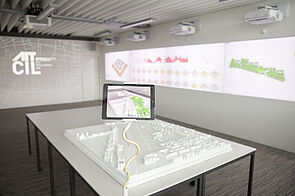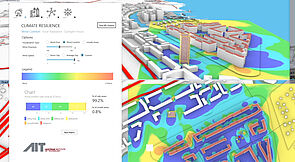AIT develops AI-controlled wind flow simulation for digital urban planning
Researchers of the City Intelligence Lab (CIL) at the AIT Center for Energy developed an artificial intelligence (AI) based simulation for wind flows. This enables wind factors to be determined in planning of cities and urban areas within seconds, allowing designs to be analysed and optimised in real time in every planning phase, taking wind factors into account. In times of extreme weather conditions, wind currents are of great importance with regard to dangerous speeds during storms, but also for fine-tuning the microclimatic conditions of a quarter. This application could be developed across national borders with the partners of Giraffe Technologies, despite the measures for COVID-19 in the interactive online platform of the CIL.
"The cities of the future must not only be equipped with smart technologies, but also be planned digitally - from the quarter to the building. With the new simulation, we can take the influence of wind currents on the microclimate, but also the effects of storms, into account right from the planning stage and adjust numerous parameters within a very short time. This real working time greatly facilitates the planning processes for our partners in both architectural and urban development projects. We can adapt these complex plans within seconds. The platform's innovative power is the use of artificial intelligence (AI) and large amounts of data to create diverse planning scenarios within the shortest possible time", explains Nikolas Neubert, Head of Competence Unit Digital Resilient Cities at the Center for Energy of the AIT Austrian Institute of Technology.
Wind currents important for microclimate in cities
Understanding urban wind flows is becoming increasingly important for urban planning, not least due to increasingly extreme weather conditions caused by climate change. "Firstly, current developments can locate and mitigate those areas with potentially dangerous wind speeds during storms. Secondly, the results can be used to fine-tune the microclimatic conditions of a neighbourhood, either to cool down or to maintain heat," explains Angelos Chronis, Head of City Intelligence Lab at the AIT Center for Energy. The CIL's online platform for collaborative design coupled with real-time analysis enables previously impossible workflows. "Getting feedback within seconds instead of hours or days is a critical factor in planning. Now designs can be analyzed and optimized in real time at every stage, taking into account wind factors," says Chronis.
Link to press release




